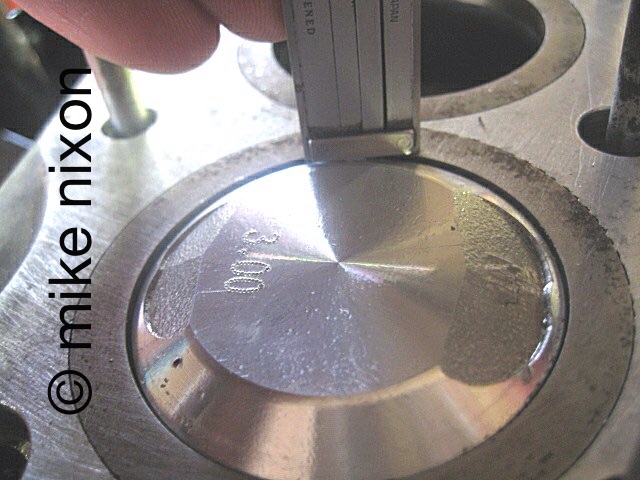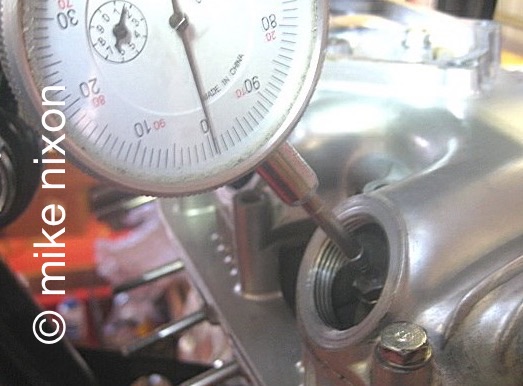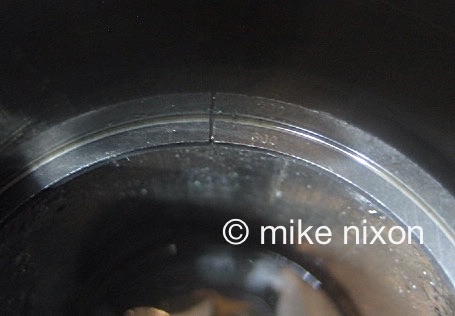  ® ®
|
|
|
|
Big Bore Kits
|

|
|
Improper deck height is why many big bore piston kits result in compression that is no higher than stock. This 3mm over Cruzinimage kit has a huge 1.1mm deck deficit. Instead of having a 170+ psi compression it had only 150 psi. After this was corrected, compression was 175 psi.
|
Big bore kits. Like high performance camshafts, big bore kits are an intriguing and exciting part of motorcycling, especially in the vintage Japanese segment.
Big bore kits do two things. First, whatever performance increase that results, and most of this is in the area of throttle response and torque, a great deal of it is due inevitably to the rehabilitation of worn areas in a moderate to high mileage engine. Big bores do not create big horsepower. All the same, they shouldn't be taken lightly. A big bore is important, it is significant, and its effects real-world streetable. Second, a large overbore such as the 3mm over kits that are popular right now actually results in increased cylinder compression, more than stock in other words, due to the sizeable jump in cylinder volume versus the unchanged combustion chamber volume. This too gives dividends in the carbureting and torque departments. Both of these things, renewed cylinder condition and increased compression, spell improved acceleration and rideability, the very best thing that could happen to an everyday vintage street bike.
But beware. A number of pitfalls must be navigated on the way to big bore kit benefits. First is the fact that it is virtually impossible to get qualified machine work done on your cylinders. See my articles elsewhere on this, but the short of it is, you'll have some anxious moments simply getting good cylinder boring, and on top of that you'll pay a premium to hog out that 1/8" of extra metal to fit that big bore kit. Second, many folks overlook the rest of the engine when doing a big bore. The cylinder head in particular is often neglected. Worn valves, tired valve guide seals, both are common and really take the sparkle off a big bore install. Add to that potential head gasket overlap, and you can see there is more to putting in a big bore kit than wrenching the parts on and off.
Especially important is the proper installation of the big bore pistons. That is, taking the time to install them correctly. And here the proverbial can of worms opens up. A handful of things come to mind in regard to non-original piston installation.
- Deck height
- Valve to piston clearance
- Cylinder clearance
- Piston quality
- Piston ring quality
- Ring end gap
- Piston pin quality
- Piston pin clip quality

|
|
No matter where the big bore kit is from, or who vouches for it, you simply must do due diligence in making sure the piston has no valve clearance issues.
|
Deck height
Deck height is important. Big bore kit pistons, especially the less expensive ones, tend to be not-all-that-well-designed Taiwanese copies of the OEM part. Deck heights that are incorrect, and valve reliefs inaccurately made, these things are unfortunately very common. This absolutely has to be checked on any non-stock setup, no matter what anyone says.
Valve to piston clearance
Valve to piston clearance also needs to be on the be-sure-to-check list, for all the same reasons as above, and more as well. No non-OEM piston should ever be installed without extremely critical valve to piston clearance checks. One bad result will convince you, if good advice won't.
Cylinder clearance
Cylinder clearance. This should be a no brainer. But, as mentioned above, it is a challenge for many. The fact is, there are other problems in addition to machinists who refuse to do it right. You also can't trust the piston supplier; you have to go by experience, and many times, like much in life, it's hard-won experience, arguably the best kind. Many of us have learned this. In some cases, fitting pistons to the supplier's recommended spec results in excessive clearance (not to mention excessive ring end gap). And of course, you can't go back. Unlike an OEM size, once a big bore cylinder is made slightly too large, you can't find pistons that are service oversizes for that big bore kit. You can't correct the cylinder by more machining. You must replace it.
Excessive cylinder clearance also results in too large a ring end gap, an all-important specification that itself is a direct result of cylinder clearance. In fact, more than anything, ring end gap is the reason cylinder clearance absolutely has to be considered very very carefully. It is easy to file a small gap larger. It is impossible to make a too large one smaller.

|
|
Ring end gap is crucial. It shows for how many miles the rings will seal, it helps determine piston oiling and compression, and it is a tip off to a correctly (or incorrectly) bored cylinder.
|
Piston quality
Next, consider the pistons themselves. Not many folks appreciate the level of quality in the stock Japanese OEM pistons. They are incredibly well engineered, suffering abuse and yet enduring almost indefinitely in standard, non-hypersport models. And at clearances that folks outside of the powersports world consider unthinkable. In actual fact, for many years in the early days of Japanese street bikes it was common for performance builders to source big bore pistons from other models of the same manufacturer's product, with slight modifications to clear valves and crankshaft flywheels. One exceptionally handy thing this did was it ensured a high quality piston. That is, one engineered right, with all the qualities needed for that engine type, including, not the least, excellent piston expansion attributes, and it guaranteed a source of the very best piston rings the industry has to offer.
Piston ring quality
Speaking of rings, perhaps the most distubing part of the commonly available Internet piston kits is the quality of their piston rings. Actually, the lack of quality. Sometimes they have directional marks, sometimes not. More importantly, they are crappy cheap. I witnessed the kit rings of a very popular eBay seller double their end gaps in less than 500 miles.
Piston ring end gap
The end gap of the piston ring is very important. It is one of the determinors of cylinder compression, and it has a huge influence on controlling oil usage. When using a piston kit, you are at the mercy of the kit maker's diligence and understanding. Making a gap larger is no problem. But no one yet has found a way to make a too large one smaller.
Piston pin quality
Finally, something I have observed is non-original piston pins in Internet advertised piston kits tend to be much poorer quality than stock. OEM pins are a hard material all the way through. Aftermarket pins are often chrome plated, not solid metal.
Piston pin clip quality
The stock Japanese street bike piston pin clip is designed to do something really interesting. As the pin drifts side to side, it actually taps the clip. The chamfer on the pin's ends meets the clip and actually forces it deeper into its groove. As I say, this is designed in. Unfortunately, nearly all of the aftermarket piston pin clips I have seen are absent this technology. Often, there is a extra tang on the clip that interferes with the ability of the pin to guarantee its clips are fully seated. Worse, the tang can actually do the reverse! It can promote clip loosening, as the pin, in its normal lateral movement, is more likely to nudge this tang instead of the body of the clip. For this reason, I refuse to use that type or piston pin clip.
Big bore kits. Gotta love 'em. But do them right. Take the time to learn and do the best practices that ensure that you get all you bargained for in that big bore kit, and that you avoid the many potential glitches, almost all of them game-changing, in the process.
|
|